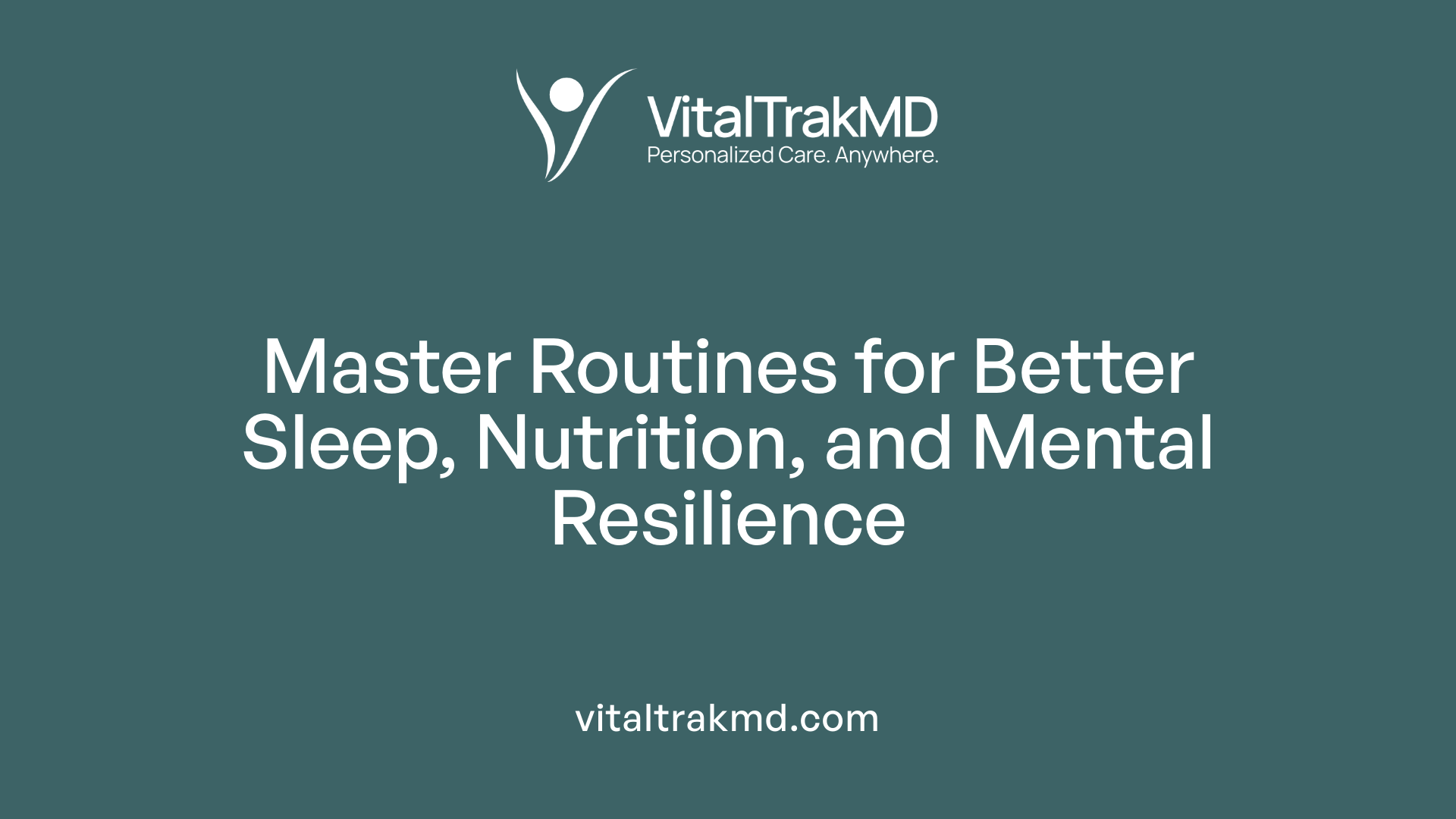Building Daily Wellness Routines With Hybrid Care Support

Embracing a Holistic Approach to Daily Wellness
As hybrid work models become increasingly prevalent, organizations face the challenge of fostering a sustained culture of wellness that integrates seamlessly into employees' daily routines. Building effective daily wellness routines supported by hybrid care strategies requires innovative approaches that combine physical activity, mental health support, digital tools, and organizational policies. This article explores comprehensive strategies, the benefits of hybrid care-supported routines, and resources to help employers and individuals cultivate habits that promote long-term health and productivity.
Establishing Consistent and Manageable Routines

What are effective strategies and tips for developing daily wellness routines?
Building sustainable wellness routines is essential for maintaining physical, mental, and emotional health, especially within hybrid work environments. The first step is starting small. Incorporate simple, manageable habits such as stretching, staying hydrated, and practicing mindfulness each morning.
Consistent schedules for sleep, meals, physical activity, and relaxation help reinforce healthy behaviors and reduce decision fatigue. For example, setting a regular bedtime and wake-up time encourages restful sleep, while planning balanced meals and dedicated exercise times fosters routine adherence.
Diversifying activities can enhance overall well-being. Activities like gentle yoga or Tai Chi improve physical flexibility, while meditation and gratitude journaling bolster mental resilience. Social interactions, even virtual, support emotional health and foster a sense of connection.
Planning ahead makes routines more attainable. Preparing meals in advance, setting reminders for breaks, and scheduling brief movement sessions during work hours help integrate wellness into daily life without feeling overwhelming.
Gradually adding new habits allows for easier adaptation. Reflecting on what activities bring the most benefit and adjusting routines accordingly ensures they remain effective and enjoyable.
Incorporate both active and restful practices. For example, start your day with stretching or a short walk, and wind down with relaxation techniques like deep breathing or reading. Maintaining balance across these domains cultivates lasting wellness habits that improve overall health.
Harnessing Technology and Digital Resources

How can digital tools and structured pathways support hybrid health and wellness routines?
Digital tools and structured pathways are transforming how organizations support employee well-being, especially in hybrid work environments. They offer personalized experiences that enable individuals to engage in health activities seamlessly, whether working from home or in the office.
One of the fundamental aspects of these tools is their ability to provide tailored tracking. Employees can monitor their physical activity, sleep patterns, nutrition, and mental health through apps, wearables, and online platforms. For instance, fitness apps like Aaptiv offer on-demand classes, allowing users to choose workouts that fit their schedules and fitness levels.
Wearables enhance this experience by providing real-time data such as step counts, heart rate, and sleep quality. When integrated with AI platforms, these devices can deliver personalized insights and recommendations, creating adaptive health plans that evolve based on individual progress and goals.
Structured pathways within digital platforms combine education, goal-setting, and routine-building features. Virtual challenges, wellness workshops, and social sharing options foster a sense of community and accountability, motivating employees to participate actively.
Moreover, digital health platforms facilitate ongoing engagement through regular updates, telehealth consultations, and feedback loops. These platforms often include features for scheduling preventive screenings or mental health sessions, making it easier for employees to access care and support at their convenience.
By bridging the physical and digital worlds, these tools ensure wellness routines are flexible, continuous, and inclusive. They support behavioral change by making healthy habits accessible and manageable, regardless of location or time constraints.
Ultimately, the integration of wearables, AI-powered apps, and comprehensive digital health platforms helps create a proactive and personalized wellness ecosystem. This approach not only improves health outcomes but also fosters a culture that values ongoing well-being, resilience, and productivity in hybrid workplaces.
| Tools & Features | Benefits | Examples/Details |
|---|---|---|
| Personalized Tracking | Tailors wellness plans, monitors progress | Wearables, fitness apps like Aaptiv, health dashboards |
| AI-Driven Platforms | Provides insights, adaptive recommendations | AI health assistants, predictive health analytics |
| Virtual Engagement & Support | Builds community and accountability | Wellness challenges, online support groups |
| Telehealth & Virtual Resources | Ensures accessible professional care | Virtual workshops, mental health sessions |
As organizations continue to adopt digital health solutions, they foster a culture of ongoing, accessible, and personalized wellness support. This not only enhances individual well-being but also promotes healthier, more engaged hybrid teams.
Implementing Hybrid Healthcare Strategies for Better Outcomes

How can hybrid healthcare strategies improve health outcomes and organizational efficiency?
Hybrid healthcare models blend in-person hospital care with remote, digital health services to create a flexible, patient-centered approach. By leveraging telemedicine, remote monitoring, and virtual care platforms, these strategies enhance access to healthcare, particularly for those in remote or underserved areas. For example, technologies like home spirometers and digital assessment tools enable continuous monitoring of chronic conditions, allowing for timely interventions that reduce complications.
Personalized care plans are central to hybrid models. They often involve comprehensive data collection, including social factors and behavioral health, to tailor treatments and promote better adherence. This approach not only improves health outcomes but also fosters patient engagement and satisfaction.
Creating a seamless integration of physical and virtual environments enhances organizational efficiency. Hospitals are redesigning infrastructure to include virtual beds and flexible spaces, optimizing resource use and reducing wait times. Workflow adjustments, such as new scheduling protocols and staff training for telehealth, streamline operations and alleviate provider workload.
Moreover, hybrid models support long-term health management through prevention, early detection, and continuous care. They help reduce hospital readmissions and lower healthcare costs, especially when combined with outcomes tracking and quality improvement initiatives.
Despite these advantages, barriers such as workforce adaptation and reimbursement policies still need resolution. Purpose-built digital health platforms, designed to support diverse care scenarios and ensure secure, compliant data sharing, are crucial for success.
In summary, hybrid healthcare strategies can revolutionize patient care by making it more accessible, personalized, and efficient. They also help healthcare organizations adapt to evolving needs, resilience during crises, and shifting patient expectations.
Creating Supportive Organizational Culture and Policies
How can organizations foster a wellness culture in hybrid workplaces?
Building a support system that encourages health and well-being in hybrid environments involves multiple strategies. Employers should leverage a variety of resources, including comprehensive wellness programs that integrate digital health tools, Employee Assistance Programs (EAPs), and wearable devices. These tools allow for personalized health support and continuous engagement.
Best practices include maintaining open lines of communication through regular check-ins and feedback channels. Creating a space where employees feel safe sharing their concerns—especially through anonymous channels—helps identify barriers to wellness and promotes inclusivity.
Leadership involvement is essential. Leaders who model healthy behaviors and set boundaries around work hours demonstrate organizational commitment to well-being. Celebrating milestones and encouraging physical activities, such as walking meetings or group stretches, can visibly promote health.
Flexible policies that emphasize mental health support are vital. This includes redefining sick leave policies to acknowledge mental health days and providing mental health education to reduce stigma.
Workspaces should be designed to support well-being, with spaces for collaboration that encourage social interaction, and digital platforms that promote community building.
Measurement tools like engagement surveys, retention metrics, and participation rates help track the success of wellness initiatives. Regular assessment enables continuous improvement.
Ultimately, fostering a resilient, connected culture requires organizational commitment to clear communication, supportive policies, and ongoing evaluation.
| Resources/Tools | Best Practices | Additional Insights |
|---|---|---|
| Wellness programs, apps, wearables | Regular feedback and anonymous channels | Model healthy behaviors, celebrate milestones |
| Employee Assistance Programs (EAP) | Redefine sick leave for mental health | Incorporate flexible policies, employee education |
| Digital communication platforms | Leadership involvement and visible commitment | Design workspace for social connection and support |
| Engagement surveys | Track participation and satisfaction | Use data to refine wellness strategies |
Implementing these strategies helps ensure that employees feel supported, engaged, and valued, fostering a culture of wellness that adapts to the evolving hybrid workplace landscape.
Building a Holistic Framework for Daily Wellness and Hybrid Care Integration
How can hybrid care models be integrated into personal and organizational health practices?
Hybrid care models blend in-person and virtual healthcare services to create flexible, accessible, and personalized health strategies. For individuals, this means combining traditional visits with telehealth consultations, remote monitoring, and digital health tools such as online portals and mobile apps. These tools enable patients to stay engaged in their health routines, schedule virtual checkups, and track progress conveniently.
Organizations can support this integration by redesigning healthcare workflows to incorporate technology and physical spaces that support both modalities. For example, setting designated days for virtual visits alongside in-clinic appointments can improve scheduling flexibility. Workspaces equipped with privacy screens and high-speed internet facilitate seamless telehealth sessions.
Effective integration also involves employing digital solutions like remote patient monitoring devices, which allow continuous health tracking and early intervention. Encouraging collaborative decision-making between patients and healthcare providers ensures care is tailored and responsive to individual needs.
Organizations like the Veterans’ Health Administration have successfully adopted these strategies, utilizing comprehensive data and technology to enhance patient outcomes. However, challenges such as resource constraints and provider workload must be addressed through strategic planning, staff training, and investment.
By creating well-structured protocols, leveraging technology, and fostering regular feedback, both individuals and organizations can embed hybrid care into daily routines—raising care quality, accessibility, and engagement. This approach promotes sustained health habits, supports ongoing preventive care, and advances toward a future where healthcare is more adaptable, inclusive, and outcome-driven.
Fostering a Culture of Wellness in Hybrid Settings
Building daily wellness routines supported by hybrid care strategies is essential for maintaining health, engagement, and productivity in today's flexible work environment. Organizations that successfully integrate digital tools, innovative healthcare models, and inclusive policies can create a resilient, health-focused culture that benefits both employees and organizational outcomes. By prioritizing continuous evaluation, community building, and personalized support, companies can foster a sustainable health and wellness landscape that adapts to evolving work paradigms and enhances overall well-being.
References
- 6 Strategies to Build a Wellness Culture in a Hybrid Workplace - Aaptiv
- Improving Employee Well-being in a Hybrid Model of Working
- How to prioritise employee wellness when hybrid working
- 5 ways that we can help you! - Hybrid Performance and Wellness
- Wellness in the Hybrid Workplace - Eight Ways to Win
- Preparing for Hybrid Care: Laying the Groundwork for Digital ...
- How to support a culture of wellbeing in a hybrid work world
- 5 Ways to Build Physical Activity into Your Hybrid Workplace Culture
- Building a Hybrid Care Delivery Model - ATA
Recent articles
Want to Feel Better and Live Healthier?
Join hundreds of patients taking control of their health with personalized care that fits their life – not the other way around.
Rated 4.8/5 by 32+ customers







